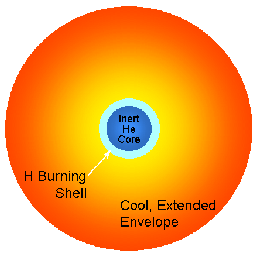red giant

General structure of a red giant.
A red giant is an evolved giant star with a surface temperature of 2,500 to 3,500°C, a spectral type of M or K, and a diameter between 10 and 100 times times that of the Sun. Red giants represent a late stage in the evolution of stars with a range of masses, from just under the mass of the Sun to tens of solar masses (see evolution of stars). The largest red giants, which form from the most massive of stars, are known as red supergiants. A red giant has exhausted its core supply of hydrogen and is now fusing hydrogen to helium in a shell outside the core. The nearest red giant to the Sun is Gacrux (Gamma Crucis).
Distances, masses, and radii of red giants
Although red giants are quite common among the stars visible to the naked eye, they are actually quite rare in space. This is because they last for only a small fraction of a star's life. Prior to the 1990s, the distances to red giants (and hence their luminosities) were not well known. Thanks to the Hipparcos mission (1989–1993), the distances to many red giants have been determined to good accuracy.
Only a few red giants have well determined masses. The mass of a star can be measured directly only if the star has a binary companion. In the case of a red giant, the companion would have been swallowed up if it was too close to the evolving star. If it was much further away, the orbital period would be centuries or more and hence less easy to determine accurately.
The radii of red giants are not only difficult to measure but are also difficult to define, because of the tenuous nature of the stars' atmospheres. At wavelengths at which the atmosphere is very opaque, the star looks much larger. Good progress is now being made, however, using optical and infrared interferometers to resolve and measure the diameters of these stars.
Red giants and variability
All red giants are believed to pulsate and therefore to be variable. A star that has only just become a red giant may pulsate and vary in brightness with only a very small amplitude; however the amplitude increases with time. When the pulsations are large, the star is said to be a Mira variableMira variable. Eventually, the pulsations help drive off the outer parts of the star, producing a circumstellar shell of gas and dust and leaving behind a remnant white dwarf core. For a few thousand years before it cools, the hot white dwarf may illuminate the gases around it, giving rise to the phenomenon of planetary nebula.
About one tenth of stars visible to the unaided eye are pulsating red giants, spectral type K5 or cooler, mostly with very small amplitude.
Pulsating red giants (apart from the Mira stars) have been much less studied than the Cepheid variables for instance, mostly because of their irregularity; it takes years or decades of observations to fully understand these stars. In the 1970s, the late Olin Eggen spent several years surveying, studying, and classifying these stars. In a series of papers (e.g., Eggen 1973), he defined small-, medium- and large-amplitude red variables (SARVs, MARVs and LARVs), and even a group of ultra-small-amplitude variables which he called Sigma Librae stars. The classification scheme of the General Catalogue of Variable Stars divides pulsating red giants into semi-regular (SR) variables with either "persistent periodicity" (SRa) or "poorly expressed periodicity" (SRb); there are also slow irregular (L) variables. Pulsating red supergiants are classified by analogy as SRc or Lc. Now we know that there is a complete spectrum of behavior among the red giants, from almost periodic to quite irregular, and from the almost-constant K5 giants, to the hypervariable Mira stars with spectral types M9 or cooler.


